Ever since I was a child the far-off romance of Tibet had played in my imagination: an unforgiving plateau high above the clouds, populated by monks and spirits; one of those places where the material world is as thin and intangible as the mountain air. Coming to the end of three dense years in Beijing and preparing my departure, it suddenly occurred to me that Tibet was, and had in fact been for some time, within my grasp.
Things to Know before Visiting Tibet
After a bit of research I discovered the following:
● To travel to Tibet, even with an existing China visa, you have to get a special permit.
● The Chinese government reserves for itself the right to close off Tibet at any time, so travelling around politically sensitive times (international summits, religious festivals etc) is not advised.
● Permits are available only through approved tour companies like Tibet Vista. The companies take care of the application process (for the most part) and it’s usually quite smooth.
How Did I Plan My Tibet Journey
I decided to book the Lhasa-Kathmandu Overland tour. I would fly to Chengdu, spend a couple of days eating hot-pot (or what veggie equivalent I could find), then take the 40 hour train up to Lhasa. Then a local guide would take myself and 10 others across Tibet to base camp and finally Gyirong, where I would cross the border myself and make the trip to Kathmandu. Shopping around, I compared a few companies before deciding on Tibet Vista, who had the best reviews and offered the best price. I paid my deposit, sent them my info, and waited for July.
After informing my contact at Tibet-Vista of my travel plans, he arranged for me to pick up my completed permit at Beijing two days before my flight to Chengdu. This in hand, I set off. Chengdu was a breath of fresh air after Beijing, and I highly recommend it - but onwards to Tibet.
Travel from Chengdu to Lhasa by Tibet Train
I boarded the train in the late afternoon, and settled in for the ride. I loaded up on fruit, instant noodles and water and boarded. I’ll spare you the long version of this trip, but suffice to say it was a good experience. I also recommend you bring instant coffee if you drink it, since the dining car and the small kiosks at each station do NOT stock it. - Check more Tibet train schedules and fares to Lhasa.
Get Acclimatized in Lhasa
Arriving in Lhasa two days later, I registered my presence with the local police then was allowed to leave the station and meet up with my guide and a few others in my tour group who had, unbeknownst to me, been on the same train. He dropped us off at the hotel we were all staying in (and in which Tibet-Vista’s office is located), warned us to take it easy and said we would meet after breakfast the next day to get the bus to Drepung monastery.
He wanted to give us another day before tackling the stairs at Potala; time to adjust to the altitude sickness. Not feeling much different - and wanting to work out the leg cramps from two days of sleeper-train - I decided to jog up the stairs to my room. One landing later I was doubled over panting. Apparently it can cause dizziness, nausea, tiredness, headaches, shortness of breath and insomnia. I was fortunate, and for the rest of my trip extra care around stairs was my only setback.
Explore Lhasa with My Travel Mate
My room was comfortable and spacious. I was sharing with a guy about my age, and on the same tour group. After some time to rest and unpack, we both decided to head out into Lhasa (the hotel is very central - about 25 minutes walk to Potala) and look for some coffee.
No luck on that, but we did find a laid back tea house, where for very little we were able to get a large thermos of yak-butter tea and two cups. The tea was good, not as sour as I’d been led to believe, and a little salty. No caffeine hit, but warm and invigorating. Lhasa has the definite feel of a frontier town. Vapoury mountains loom high over every street, farmers stride the streets in their chubas, unadorned concrete storefronts open onto piles of freezing yak-meat or vast slabs of butter. In the cramped and busy streets around Jokhang temple pilgrims endlessly walk the kora, marking their circuit around the temple in prostrate body lengths. - Learn more of what to eat and which restaurant to dine in Tibet.
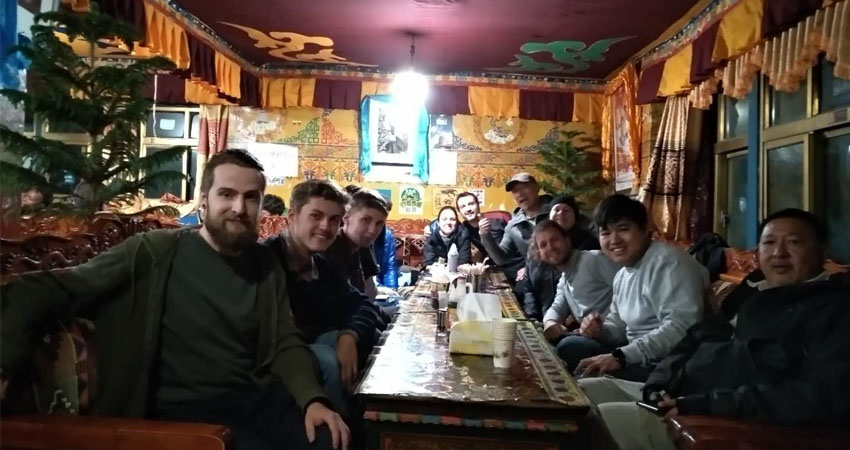
Dine in a local restaurant in Tibet
The next day we met early to take a bus to Drepung monastery, the former residence of the Dalai Lamas until Potala was built. More like a small town than a monastery, the campus at one time housed around 10,000 monks, but today has far less. Steps carved into the flanking hillside marked the widest route of the kora - the most important temples have several concentric routes to complete before entry - we followed this path as far as a giant mural which was in the process of being restored. Entering the temple grounds across a small rain gutter, we witnessed our first example of an automated prayer wheel, the bronze bell attached to a propeller in the gutter so the relentless plateau rain could be put to work at the wheel of dharma.
The monastery kitchen was a cavernous hall propped on stone and wooden pillars where vast steel tureens were set shoulder high in a warm stone slab. A shelf of flasks sat in a queue as the lone monk stirred the next batch of butter tea, and one of the monastery’s many cats lay purring in the warm shade. Our guide gave us a short lesson in Tibetan, and the history of the place. As we toured the temple proper, we learned more about the Vajrayana (thunderbolt vehicle) style of Buddhism practised across Tibet.
Back in Lhasa the bus took us to a small restaurant, and then on to Sera monastery. While smaller than Drepung, Sera is closer to town and was therefore much busier. We were there to witness the monks debate, which they do in the shade of a begravelled orchard. A junior monk pairs up with a senior instructor, who questions them according to a strict protocol. The junior monk responds according to a prescribed formula. The spectacle is lent a surreal air by the actions of the instructor, who lunges and claps for emphasis each time he questions his disciple. Picture the chaos of nearly 100 monks all engaging in this ritual in their own pairs.
Devotion runs through Tibet like a great brass wheel, always turning clockwise. Prayer flags billow from every peak and pilgrims walk the koras, some of them carrying prayer wheels which turn endlessly like the great bell-shaped wheels in the temples, each wheel singing a mantra as it turns. It’s easy to feel overwhelmed in a place like this. Ancient, yet the wheel still turns, guided by the hands of the living.
The next day we left after breakfast for Potala Palace. We arranged to meet in the courtyard at the top in half an hour, then set off at our various paces. In the courtyard our guide explained that we would have a short amount of time to make our way through the building and meet at the far end. Photos were forbidden. Potala is massive, and we saw only a small fraction on our route but it felt like a good cross-section, from the personal residence of the Dalai Lamas, across the rooftop (a kind security guard let me onto a ledge to take a photo of the view of Lhasa, after I assured him I wasn’t photographing the Palace) and through the heart of the palace and the tombs of the former Dalai Lamas, solid gold stupas of staggering weight. At the other side we reconvened and headed to a cute little restaurant near Jokhang where we had a chance to relax and take in the view of the temple area from our third floor balcony.

Tour Potala Palce with the group members
Jokhang is the heart of Lhasa. Established by Songtsen Gampo to house two great Buddhas, it’s surprisingly small and cramped, full of annexes and alcoves that spiral out from the main loop, housing relics and statues. - Find out all the highly popular attractions in Lhasa.
Leaving Lhasa for Shigatse, the Gateway City to Mt. Everest
Day 3 saw us leaving in the early morning for Shigatse, the next largest city and traditional seat of the Panchen Lama. We stopped at various passes to stretch our legs, eat and see the bizarre petting zoos that have sprung up around them, where you can pay 40 kuai to take a photo next to a yak or Tibetan mastiff. Be careful here; don’t ask about the price of anything if you’re not prepared to buy. The sellers are persistent, and I found it quite stressful when a woman selling hand-stitched prayer flags pursued me back to the bus after I realised I didn’t have the cash on hand to buy them.
If Lhasa is a frontier town, Gyantse is pure wild west. The town and monastery there are overshadowed by the tiny but imposing fortress that stands on a narrow hill. We spent an hour exploring the monastery by ourselves before regrouping and heading onwards to Shigatse, arriving in time for dinner. The hotel here was much the same as in Lhasa, if anything more comfortable. Myself and some friends set out to find a local club. In Lhasa we had visited some bars, made some friends and learned a lot about the Tibetan people, who likewise were eager to learn about our own home countries.
In Shigatse we ended up in a bizarre little club, where each table was decorated with about 20 unopened bottles of beer but nobody seemed to be drinking. Instead groups of men (and they were nearly all men) were taking it in turns to go onstage and perform swaggering group karaoke sessions. It was an odd experience, but the beer was cheap.
The next morning we visited Tashilunpo monastery, in my view the most impressive and well-maintained one we had visited. There are several large houses here, each holding a leviathanic Buddha, the walls adorned with beautiful mural paintings.
Go Straight to Everest Base Camp
After the monastery we hit the road again, stopping only at a small roadside cafe. A word about the food: while Tibet as a whole is quite poor and many Tibetans are subsistence farmers, our guide took us to places that, even seemingly in the middle of nowhere, were able to provide cheap and filling food, and there was always a good vegetarian option. In this instance they served vegetarian momos, the local style of dumplings, along with a few rice and vegetable dishes. After this we took a winding road over a mountain pass and up into the Himalayas. The weather was fickle, and we were all nervous that we might come so far and not see Qomolangma. Our guide was nervous too (“no Qomolangma, no tips” he confided from experience). - Check the best time to visit Everest Base Camp in Tibet.
As we zigzagged up and then down amidst the giants, where clouds slept in the hollows like ragged sheep, our nervousness grew. After all the sights and experiences of Lhasa and Shgatse, it was stupid to lay everything on the whims of a sky we couldn’t control and a mountain we weren’t even planning to climb, but nevertheless I think we all did.
As the bus sped along a straight stretch of highway, barley-fields to our left and right, our guide shouted out; there it was. A cloud had moved, and a luminous white arrowhead was barely visible against the pale sky. We braked the bus, ran out, jumping and yelling and taking pictures. As we got closer the view go even better.
Brief Stay at EBC
Basecamp was a squat quadrangle of ger-style tents, smoke rising from each. We trekked for half a mile up the pass, stopping at Rongbuk monastery on a rocky spur to explore and enjoy the view. We headed a short way back down the road to the monastery guesthouse.
Six of us shared one room here: I recommend taking earplugs if you’re a light sleeper, chances are someone will snore.
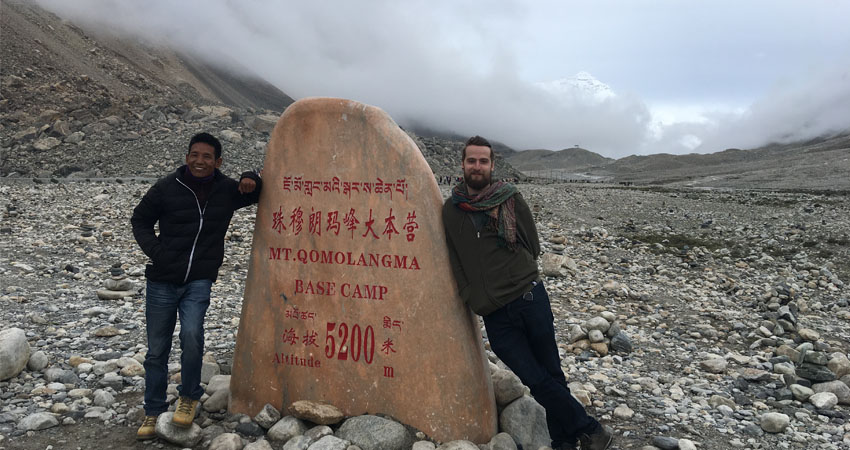
Leave the footmark at EBC
The guesthouse served good dinner and breakfast, and after rising early we individually made our way down the road to see Qomolangma as dawn rose. The sky was clear, and the view incredible.
My Impression of Gyirong, a Small Place at Sino-Nepal Border
After this there was nothing left except for the 300km drive to Gyirong. This felt like the longest drive on the tour. Before leaving Beijing I had loaded my phone with two audiobooks, about 100 hours of podcasts and filled the remaining space with playlists of new music. I had three books with me, but could only read in the bus on the straighter more even stretches.
I also had two spare charge packs, which I topped up at each hotel. Water and snacks also came in very handy. We all talked and got to know each other on the bus, and intermittently our guide would engage us on topics of Tibetan culture. Still though, it was a lot.
The Gyirong was not a pretty place. Basically a bus depot on the Nepali border, apparently the whole town was less than 10 years old at the time of visiting. After scouring the whole town we found one place that served vegetarian food. Still, at least there was one. First thing in the morning we headed down the smooth, nearly empty highway. The landscape had changed as we approached Gyirong; barren crags and mined gullies gave way to jungle, and clouds morphed to curtains of mist as we crept down the valleys. After Gyirong it changed even more before we reached the border proper.
I wish I had something nice to say about the border, but it was a gruelling wait. On the other side the road immediately deteriorated into potholes and mud, and we were stuck for several hours behind a landslide on the way to Kathmandu. Gyirong was where I parted ways with our Tibet-Vista guide though. He gave us good advice for the next stage of our trip, and had a guide on the other side to help us get our visas and find the bus, but the border was where we tipped him and the driver for their service and parted ways.
I’d recommend the trip highly to anyone. Tibet isn’t a storybook; it’s a real place with real people and complex stories. Travel responsibly and meet people with openness and humility; you will learn a lot. It’s a heartbreakingly beautiful place, and I know one day I’ll be back.


.jpg)




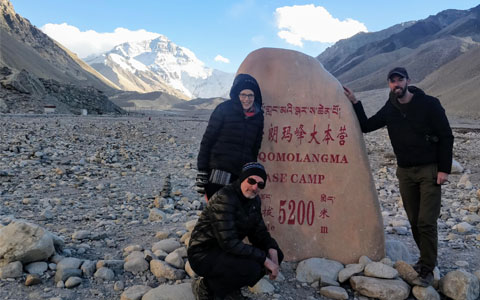

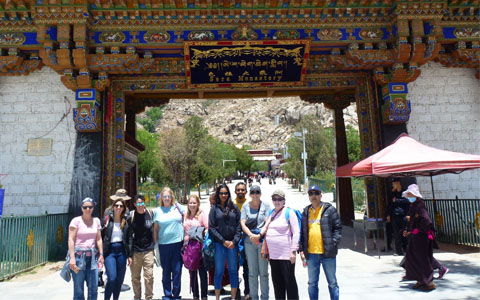
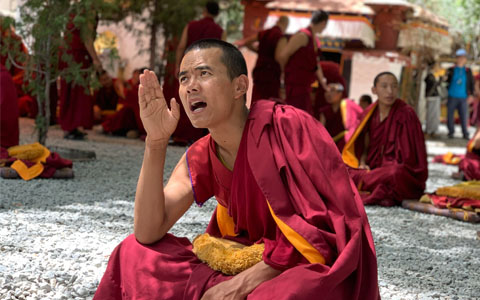

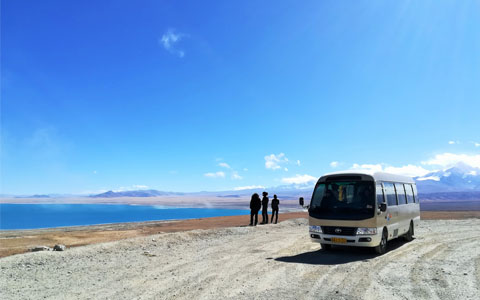
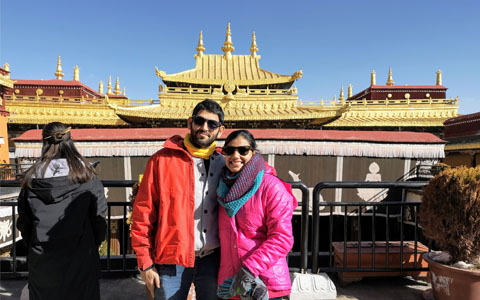


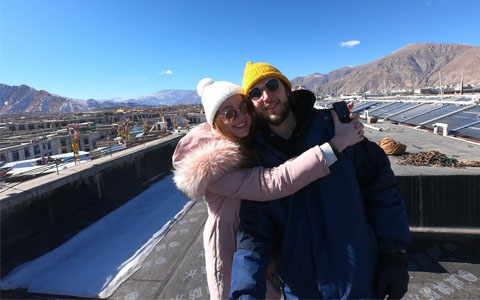
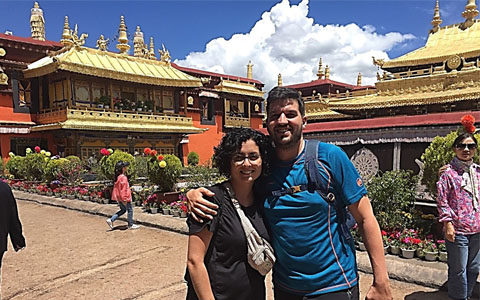
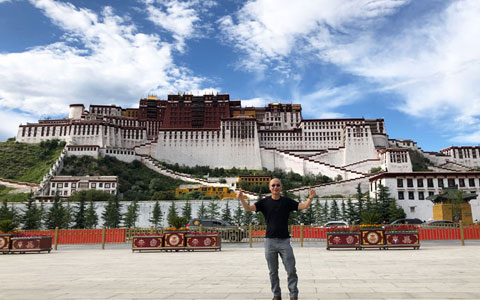
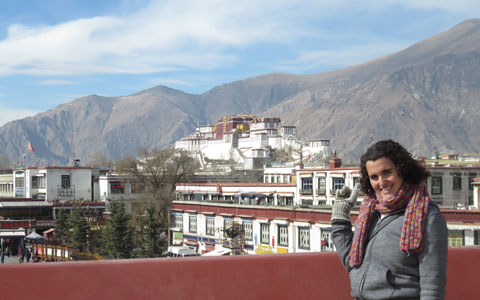


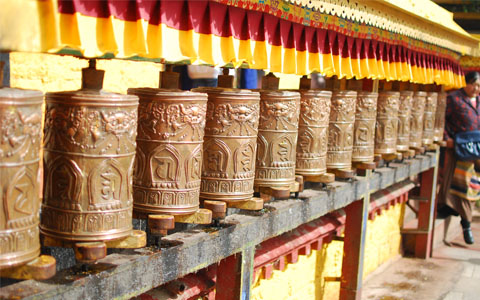
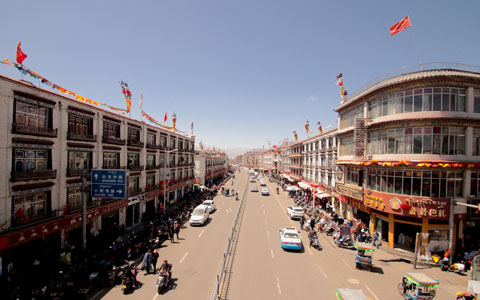

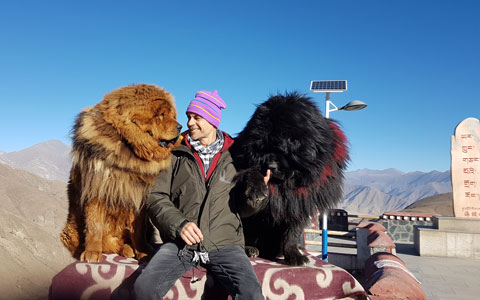
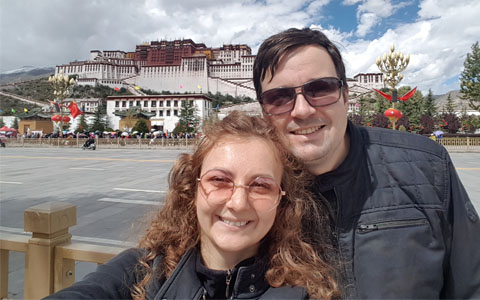

0 Comment ON "Had My Childhood Dream Fulfilled: the Amazing Lhasa to Kathmandu overland Tour"